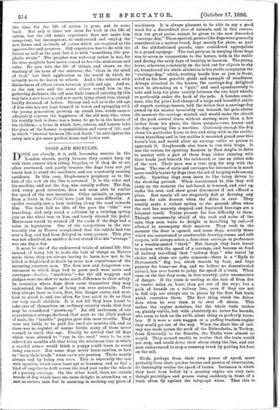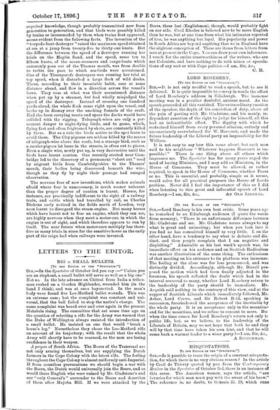DOGS AND BICYCLES.
DOGS are already, it is said, becoming scarcer in the London streets, partly because they cannot keep up with their owners when riding bicycles, or if they do so are often overtaxed, and partly because the dogs have not yet learnt how to avoid the machines, and are constantly causing accidents. In this case, Stephenson's prophecy as to the fate of the cow on the line is reversed. It is the rider and his machine, and not the dog, who usually suffers. The dog, with every good intention, does not seem able to realise the speed of the new invention. Other animals, as appears from a letter in the Field, have just the same difficulty. A cyclist recently saw a hare trotting along the road towards him. The hare had no idea of the pace the " bike " was travelling, and only saved a collision by a twisting spring just as the wheel was on him, and barely cleared the pedal. Motor-cars would be warned off the roads if the dogs had a voice in legislation. One of the competitors in the race recently run in France complained that his vehicle had run over a dog, and had been delayed in consequence. This plea was not admitted, as another di iver stated that his "average" was one dog a day.
It must be one of the undeserved trials of animal life that instead of being left to make the best of things as Nature made them, they are always having to learn how not to be killed or frightened to death by some new contrivance of the inventing creature, man. The first new and dangerous con- trivances to which dogs had to grow used were carts and carriages—Scotie6, "machines "—for the old waggons and sledges were too slow to make much difference to their safety. In countries where dogs draw carts themselves they may understand the danger of being run over naturally. Here they always have to learn, first, that danger exists, and next, how to avoid it, and are often far less quick to do so than are very small children. It is not till they have learnt to take care of themselves on ordinary country roads that they may be considered "grown-up." An old exciseman of our acquaintance always declared that next to the illicit makers of malt, the " taxable " puppies gave him most trouble. They were not liable to be paid for until six months old, and as there was no register of canine births many of them never seemed to reach this age. Finally he settled that all dogs which were allowed to "run in the road" were to be con- sidered six months old, that being the minimum time in which a careful owner would think a puppy could learn to avoid being run over. But some dogs never learn caution, or how to "keep their heads" when carts are passing. These nearly always end by being run over. This is especially the case with spaniels, which seem least apt at learning, and to feel a kind of impulse to drift across the road just under the wheels of a passing carriage. On the other band, there are certain breeds of dog which have the same delight in attending on a cart as certain men feel in assisting in working any piece of
machinery. It is always pleasant to be able to say a good word for a discredited race of animals, and in this connec- tion too great praise cannot be given to the now discarded "carriage dog." These spotted, pointer-like dogs were generally considered as a useless breed, kept merely for show, as part
of the old-fashioned parade, once considered appropriate to a grand equipage. The real purpose in keeping these dogs was to serve as companions to the horses, both in the stable and during the early days of training to harness. The young horse, otherwise constantly on the look out for objects to shy at, transferred his whole attention to his stable companion the- " carriage-dog," which, trotting beside him or just in front, acted as the best possible guide and example of steadiness. Always attached to the horses, the carriage-dog delighted most in attending on a "pair," and used spontaneously to take and keep his place exactly between the two hind wheels, or preferably under the hook of the pole. A London coach- man, who for years had charge of a large and beautiful stable of superb carriage-horses, told the writes that a carriage-dog owned by his master invariably ran beneath the pole-chains- the moment the carriage started, and would make the circuit. of the park several times without moving more than a few inches from his place, the three animals—two horses and the dog—moving like a machine. Curiously enough the dog chose his particular horse to live and sleep with in the stable; when travelling and in inn stables it mounted guard over this horse's box, and would allow no strange ostler or groom to. approach it. Greyhounds also learn to run with traps. It- was the custom for sporting farmers in East Anglia to drive to market with a pair of these dogs, either running witl? their heads just beneath the tail-board, or one on either side- d the cart. Their pace was a trot, step for step with the horse. The use of carts and carriages for locomotion is much more readily learnt by dogs than the art of keeping safe among traffic. Sporting dogs soon learn to like being driven to. the shooting ground. When accustomed to this they will jump up the moment the tail-board is lowered, and curl up. under the seat, and show great discontent if not offered a. place. But nearly all are singularly dull at devising any means for safe descent when the drive is over. They usually make a violent spring to the ground, often whem the cart has scarcely stopped, and fractured fore-legs are a. frequent result. Trains present far less difficulty to them. Though occasionally afraid of the rush and noise of the- cars, they soon learn to delight in travelling by rail,—if allowed to accompany their masters. They rush in the moment the door is opened, and some dogs, notably those- which are accustomed to comfortable drawing-rooms and soft. carpets, will always select a first-class carriage in preference to a wooden-seated "third." But though they have learnt. to reckon with the speed of a carriage, and become so fond' of railway travelling that "railway dogs" who travel by choice and alone are quite common—there is a. "Hyde to. Portsmouth" dog too, which travels by boat, and begs pennies for buns—no dog, and we believe no domesticated animal, has ever learnt to judge the speed of a train. When once on the line they seem, in this country, quite unconscious of danger. If the train is moving at the rate of from five to twelve miles an hour, they get out of the way; but a. pack of hounds on a railway line, even if they are not in full cry, are always cut to pieces by the first fast train. which overtakes them. The first thing which the driver does when he sees them is to shut off steam. This makes the engine noiseless, but the whole train rushes on, plainly visible, but with absolutely no terror for hounds, who seem to look on the swift, silent thing as perfectly harm- less. If it were a corn waggon or a puffing traction-engine they would get out of the way. When the short line of rail- way was made across the neck of the Dobrudscha, in Turkey, from Knstendji to the Danube, the Turks were almost as stupid. They seemed unable to realise that the train would not atop, and would drive their sheep along the line, and one man endeavoured to stop a runaway truck by putting his foot on the raiL Birds, perhaps from their own power of speed, more probably from their quicker brains and powers of observation, do thoroughly realise the speed of trains. Instances in which they have been killed by a passing engine are very rare, though partridges and grouse rising suddenly in front of a train often fly against the telegraph wires. That this is acquired knowledge, though probably transmitted now from generation to generation, and that birds were possibly killed by trains or incommoded by them when trains first appeared, seems evident from the following facts. The invention of the ." torpedo-boat-destroyer "raised the maximum speed obtained at sea at a jump from twenty-five to thirty-one knots. But the difference between the speed of a destroyer running her trials on the Maplin Sand, and the speed, some ten to fifteen knots, of the ocean-steamers and cargo-boats which commonly pass out of the Thames month, was from double to treble the pace to which sea-birds were accustomed. One of the Thornycroft destroyers was running her trial at top speed, when it disturbed a large flock of wild ducks. These, according to their invariable habit, rose at some distance ahead, and flew in a direction across the vessel's bows. They rose at what was their accustomed distance when put up by a steamer, but had wholly misjudged the speed of the destroyer. Instead of crossing one hundred yards ahead, the whole flock came right upon the vessel, and bloke up in dismay over the smoking funnels of the craft. Had she been carrying masts and spars the ducks would have -collided with the rigging. Telegraph-wires are only a per- manent danger to night-flying birds, and to game, which, flying fast and often frightened by shots, are constantly killed by them. But as a rule the birds native to the spot learn to avoid them. The City pigeons are seldom killed by the mazes -of telegraph-wire above the roofs, but a strange bird, such as a carrier-pigeon let loose in the streets, is often cut to pieces. Even a single wire, newly put up, is very destructive until the birds have learnt caution. One recently erected near Cam- bridge led to the discovery of a permanent "short cut" used by migrant birds from Cambridgeshire to the Thames' mouth, their bodies being discovered beneath the wire, though as they fly by night their passage had escaped -observation.
The nervous fear of new inventions, which makes animals afraid where fear is unnecessary, is much sooner unlearnt than the proper degree of caution is learnt. Horses, for instance, are practically indifferent to the sight of a railway train, and cattle which had travelled by rail, as Charles Dickens early noticed in the fields north of London, very soon learnt to disregard the steam-engine. But many horses which have learnt not to fear an engine, which they can see, are highly nervous when they meet a motor-car, in which the engine is out of sight, and which therefore appears to run by itself. The near future when motor-cars multiply has there- fore as many trials in store for the sensitive horse as the early part of the reign had when railways were invented.







































 Previous page
Previous page